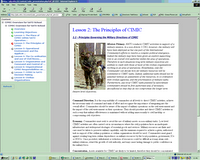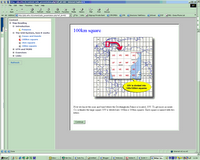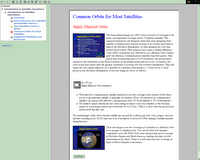 Introduction to NATO V 3.1 ( updated Dic 2005)
Introduction to NATO V 3.1 ( updated Dic 2005)
The purpose of this course, Introduction to NATO, is to provide an introduction to NATO structures, policies and operations, as well as an overview of the current issues facing the Alliance. The course is primarily designed for the benefit of regular and reserve officers and civilian officials from NATO and Partner Countries who are assuming national or international responsibilities in the security field. Students who complete this basic course will acquire the level of knowledge and understanding necessary to enable them to benefit more fully from the advanced NATO courses offered by the NATO School, the NATO Defense College, the National Defence Colleges and training institutions in NATO and PfP countries and the PfP training centres.
CIMIC Overview for NATO School
Upon completion of this module, you will be able to understand the place of CIMIC within NATO, Operations, the principles of CIMIC, the operational environment and the application of CIMIC, the management of Civil resources, the organization and command and control of CIMIC forces, CIMIC responsibilities and operational CIMIC tasks, CIMIC planning, and Civilian organizations.
NATO Introduction to Reserve Forces
The NATO Introduction to Reserve Forces module provides operational information to all Reserve Officers. It contains relevant links, documents and explanations to understand the role of Reserve Officers in the NATO structure. This module is the first phase of training in a two phase course. The second phase of training is in the resident phase, held at the NATO School in Oberammergau, Germany. This training instills in students an understanding of the various roles, missions and doctrines of Reserve Forces throughout the Alliance. Building on Military Committee (MC)policy, the training surveys how the Alliance integrates Reserve Forces in current Operations. To do this, the course explores numerous national "best practices" in a comparative analysis framework. A wide range of topics, common to most Alliance and PfP nations, are surveyed.
 European Security and Defence Policy (ESDP)
European Security and Defence Policy (ESDP)
This course provides an introduction into the European Security and Defence Policy (ESDP). It discusses the most important aspects of and questions related to ESDP. This includes an overview of the history of ESDP, European Union (EU) institutions concerned with implementing ESDP, EU civilian and military capabilities, the relationship between the EU and NATO, and EU operations carried out within the framework of ESDP. The last lesson provides a glimpse into the future and discusses some of the most important current and future challenges to ESDP.
Introduction to Satellite Operations
This course is an introduction to satellite operations focused on the physical behaviour of satellites in space. The course uses pictures, animations, links to other websites, and narratives in non-technical terms to accomplish the course objectives. Upon completion of this course, you will be able to, 1. List and describe basic satellite subsystems. 2. Recall basic principals and laws of satellite orbits. 3. Explain basic terminology used to describe satellite orbits. 4. Explain the advantages and disadvantages of different satellite orbits. 5. Summarize how different orbits are employed in support of military operations. 6. List and describe the major orbital perturbations.
Map Reading
This SWEDINT Map reading Course has been created by SWEDINT and developed in the PfP Consortium's Learning Management System (PfP LMS) by the Swedish Cooperative Development Team (CDT). The purpose of this course is to provide an introduction to Map reading with focus on handling UTM and MGRS Co-ordinate system.






